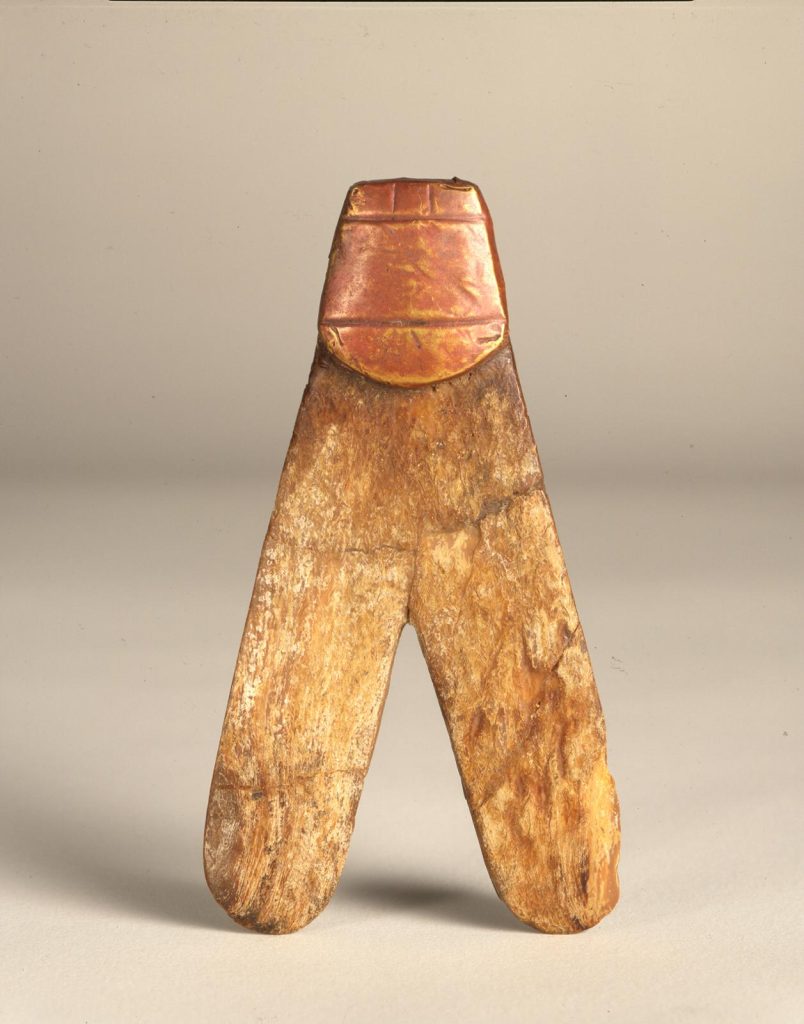In the course of excavations at site GiE003—a Kerma Moyen–Kerma Classique cemetery at Ginis East—we found a small intriguing object in a large, roughly rectangular Kerma Classique tomb containing nice pottery and the remains of a large funerary bed (sadly, extremely fragile and badly preserved).
At first, it was difficult to determine the nature of the object, made of ivory and measuring c. 2.3 x 2.2 cm (figure 1). However, after looking at Reisner’s report on the excavations at the cemeteries of Kerma I could determine that the object was actually the upper part—the body—of a fly pendant!

Based on my extensive research on New Kingdom cemeteries in Nubia, I was expecting that Bronze Age cemeteries in the region of Ginis in general would comprise mostly non-elite contexts, as is the case with New Kingdom burial contexts in the Batn el-Hajar (Edwards 2020) or rural, small-scale communities in the Kerma hinterland at Abu Fatima (Akmenkalns 2018).
The overall wealth of the community buried at Ginis—at least in the Kerma Classique Period—surprised me a bit. The closest parallel to the tombs we excavated at Ginis would probably be the Kerma cemetery at Ukma West, both in terms of tomb architecture and grave goods (Vila 1987). At GiE003, wealthy archaeological contexts were detected, including animal offerings, funerary beds and especially grave goods, including a glazed steatite Second Intermediate Period scarab—which works as evidence for long distance trade—and our interesting fly pendant.
Fly pendants were found at Kerma (Reisner 1923). Those were made of gilded ivory or bronze. Fly pendants were also found at Semna (ivory; Dunham and Janssen 1960) and Buhen (electrum body and ivory wings; Randall-McIver and Wooley 1911; figure 2). At Kerma, fly pendants were usually associated with bodies wearing swords/daggers, which led Egyptologists to transfer the Egyptian military symbolism attributed to flies in the New Kingdom to Kerma contexts (Binder 2008). However, as these objects became more common in the Kerma Classique Period, one could hypothetically establish a connection between flies and the Kerma expansion (Manzo 2016).

Despite not being made of gold or electrum, the fragmentary fly pendant from Ginis works as evidence for the relative wealth of the community buried at the cemetery, which raises questions about the source of such wealth in the context of Bronze Age geographical “peripheries” in Nubia. The object also allows us to discuss other topics, such as identities and social hierarchies, but I need more research time before I’m able to do discuss these any further. Nonetheless, the fly pendant from Ginis allows us to catch glimpses of the potential of material culture to reveal unknown aspects about Kerma communities living outside of Kerma and therefore to understand cultural diversity in Bronze Age Nubia.
References
Akmenkalns, J. 2018. Cultural Continuity and Change in the Wake of Ancient Nubian-Egyptian Interactions. PhD thesis, UCSB.
Binder, S. 2008. The Gold of Honor in New Kingdom Egypt. Oxford: Aris and Phillips.
Dunham, D. and J. Janssen. 1960. Second Cataract Forts. Boston: Museum of Fine Arts.
Edwards, D. 2020. The Archaeological Survey of Sudanese Nubia. Oxford: Archaeopress.
Manzo, A. 2016. Weapons, Ideology and Identity at Kerma (Upper Nubia, 2500-1500 BC). Annali, Sezione Orientale 76: 3-29.
Randall-McIver, D. and L. Wooley. 1911. Buhen. Philadelpha: University Museum.
Reisner, G. 1923. Excavations at Kerma. Cambridge, Mass: Peabody Museum.
Vila, A. 1987. Le cimetière kermaïque d’Ukma Ouest. Paris: CNRS.
